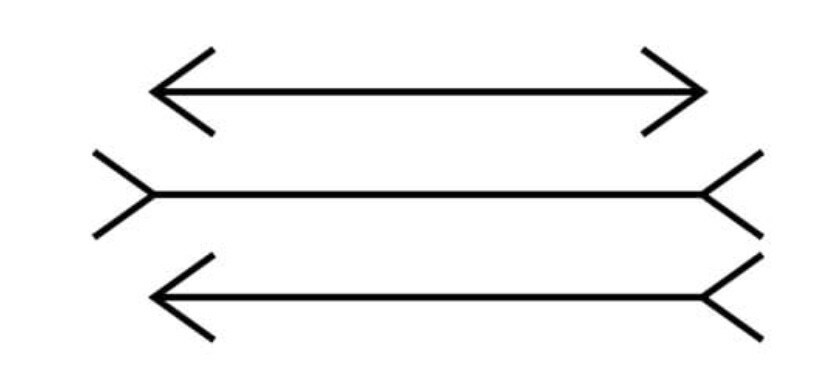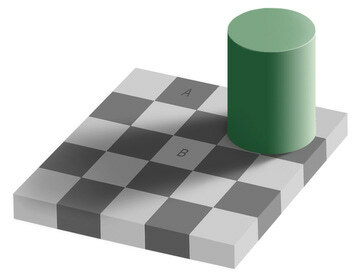You’re probably familiar with visual illusions like the image below:

Even though the horizontal line in the middle looks like it’s longer than the horizontal lines on the top and the bottom, it’s actually the same length.
Which square is darker, A or B?

They’re actually the exact same color.
Our visual perception can sometimes mislead us — our eyes tell us that something is true when reality says it isn’t.
LSAT logical reasoning involves many “verbal” illusions. For example, if you’re reading and thinking too quickly, it’s easy to overlook subtle shifts between different concepts:
LSAT logical reasoning involves many “verbal” illusions. For example, if you’re reading and thinking too quickly, it’s easy to overlook subtle shifts between different concepts:
“Letting children drink moderate amounts of soda is not harmful to them.”
“Letting children drink moderate amounts of soda is acceptable.”
Of course, when you’re reading slowly, you’ll notice that something being “not harmful” does not necessarily mean it’s “acceptable”. Maybe there are other reasons letting kids drink soda isn’t acceptable separate from issues of harm?
“The accident rate increased on the highway.”
“The number of accidents increased on the highway.”
An accident “rate” involves the number of accidents divided by another variable - usually it’s number of accidents per kilometer driven. So an accident “rate” isn’t exactly the same as the overall number of accidents. An accident rate can increase, even if the overall number has stayed the same or decreased.
Too often, a subtle concept shift like those above is what causes LSAT students to fall for a wrong answer or to overlook a flaw in an argument.
That, of course, leads to the question, how do you avoid falling for these verbal illusions? How do you reliably notice when two words or phrases really describe different ideas, even if they seem the same on a first look?
Well, think about the illusion about the three lines of equal length. How would you actually tell whether they are different or the same in length? You’d have to stop and measure them with a ruler, or draw some vertical guide lines like this:
Too often, a subtle concept shift like those above is what causes LSAT students to fall for a wrong answer or to overlook a flaw in an argument.
That, of course, leads to the question, how do you avoid falling for these verbal illusions? How do you reliably notice when two words or phrases really describe different ideas, even if they seem the same on a first look?
Well, think about the illusion about the three lines of equal length. How would you actually tell whether they are different or the same in length? You’d have to stop and measure them with a ruler, or draw some vertical guide lines like this:

And how would you actually tell that square A and B are the same or different color? You might have to cover up the areas around the squares to better compare them, or manipulate the picture to show the colors side by side:

There’s no other option. Perhaps after you study hundreds of similar illusions you’ll get better at estimating the length of two lines or telling whether two squares are the same color, but you’ll never know for sure until you do something to help you measure — something beyond just looking at the image.
That’s true of the LSAT, too. You won’t get the kind of score you want if you rely only on going with your first snap interpretation of each sentence. You have to “measure” that interpretation. “Measuring” on the LSAT could mean asking yourself, “What does this word mean? And what does this other word mean? Do they mean the exact same thing, or is there a small shift?” Or, when it comes to conditional language, “measuring” could involve drawing a diagram based on the rules you’ve learned about “only if”, “unless”, and “no”.
Ultimately, “measuring” on the LSAT means slowing down and being critical of your own reading. Imagine you had to answer the question “Why do you think that?” at every step of your analysis. To that end, don’t worry about reading speed. Worry, instead, about whether you’re asking yourself the right questions:
“I think this is the conclusion. Why? First, it’s the author’s recommendation about what should happen, which is very often a conclusion. But also, it’s the conclusion because it’s supported by this other statement, and it doesn’t seem to support anything else in the stimulus.”
“It looks like a correlation to causation flaw. Why? First, the premise presents a correlation. Why is that a correlation? Because it simply says that one thing ‘tends to be’ another thing, which isn’t causal language. Second, the conclusion is a causal statement. How do I know? Because it says that one thing ‘promotes’ another. ‘Promoting’ is a causal verb.”
“If I’m going to pick this answer, I have to believe that the argument was assuming that the mayor’s plan was necessary to solve the budget problem. The argument’s conclusion says ‘If we want to solve the budget problem it would be a good idea to adopt the mayor’s plan.’ Is saying that it would be a ‘good idea’ to adopt the plan the same thing as saying we *need* to adopt the plan? No, so it turns out this answer is wrong.”
If you start having this kind of conversation with yourself as you review LSAT questions and even as you take a practice test, you’ll be on your way to lasting improvement.
That’s true of the LSAT, too. You won’t get the kind of score you want if you rely only on going with your first snap interpretation of each sentence. You have to “measure” that interpretation. “Measuring” on the LSAT could mean asking yourself, “What does this word mean? And what does this other word mean? Do they mean the exact same thing, or is there a small shift?” Or, when it comes to conditional language, “measuring” could involve drawing a diagram based on the rules you’ve learned about “only if”, “unless”, and “no”.
Ultimately, “measuring” on the LSAT means slowing down and being critical of your own reading. Imagine you had to answer the question “Why do you think that?” at every step of your analysis. To that end, don’t worry about reading speed. Worry, instead, about whether you’re asking yourself the right questions:
“I think this is the conclusion. Why? First, it’s the author’s recommendation about what should happen, which is very often a conclusion. But also, it’s the conclusion because it’s supported by this other statement, and it doesn’t seem to support anything else in the stimulus.”
“It looks like a correlation to causation flaw. Why? First, the premise presents a correlation. Why is that a correlation? Because it simply says that one thing ‘tends to be’ another thing, which isn’t causal language. Second, the conclusion is a causal statement. How do I know? Because it says that one thing ‘promotes’ another. ‘Promoting’ is a causal verb.”
“If I’m going to pick this answer, I have to believe that the argument was assuming that the mayor’s plan was necessary to solve the budget problem. The argument’s conclusion says ‘If we want to solve the budget problem it would be a good idea to adopt the mayor’s plan.’ Is saying that it would be a ‘good idea’ to adopt the plan the same thing as saying we *need* to adopt the plan? No, so it turns out this answer is wrong.”
If you start having this kind of conversation with yourself as you review LSAT questions and even as you take a practice test, you’ll be on your way to lasting improvement.
